Early English Playing Cards
Early examples of traditional, standard English playing cards of which the best known are those of Hewson of the seventeenth century, and Blanchard from the eighteenth century.
 HE EARLIEST ENGLISH playing cards are very scarce… few specimens have survived and little is known about the manufacturers.
This page exhibits several early examples of traditional, standard English playing cards of which the best known are those of Hewson of the seventeenth century, and Blanchard from the eighteenth century.
HE EARLIEST ENGLISH playing cards are very scarce… few specimens have survived and little is known about the manufacturers.
This page exhibits several early examples of traditional, standard English playing cards of which the best known are those of Hewson of the seventeenth century, and Blanchard from the eighteenth century.
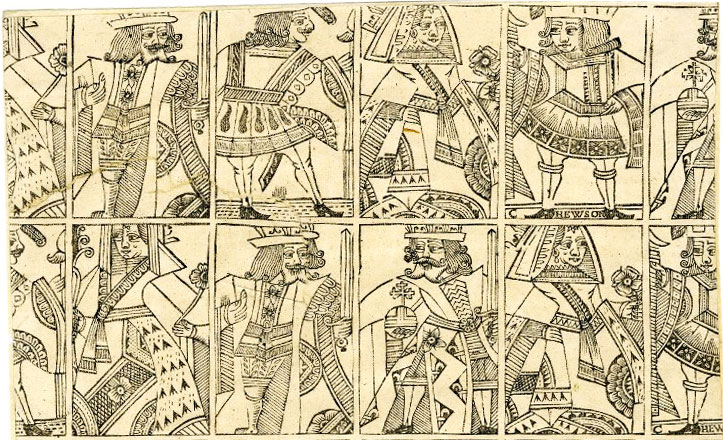
Above: early English Playing Cards, fragment of an uncut, uncoloured sheet c.1650. The name "HEWSON" is inscribed on the Jack of clubs. These designs are not as stylised or corrupted as later examples, and many details and features are still recognisable (click to see enlargement).
An Exciting Find
Whilst renovating a house in Ross-on-Wye, and having removed the floorboards in the attic, workmen discovered 33 rather old playing cards: 9 court cards and 24 pip cards in varying states of wear and deterioration.
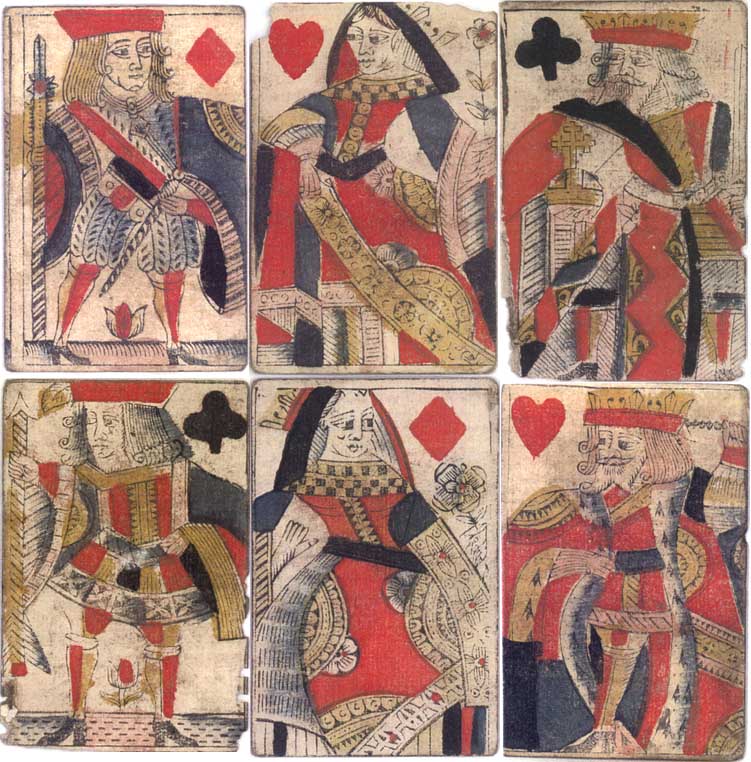
Above: Early English Playing Cards c.1725, found under floorboards. There is no maker's name on any card.
It is unusual to find so many cards under floorboards, and suggests that the cards may have been hidden there. One recalls edicts and laws forbidding card playing to servants and apprentices except during the Christmas holidays. The maker is unidentified, and there is no Ace of Spades or tax stamp, however there are clues which assist in dating the cards:
King of clubs: early style with Cross of Lorraine on an imperial orb
King of hearts: early style wielding an axe
King of diamonds: armed with a battle axe
Queen of hearts: a very long, thin stalk to the flower
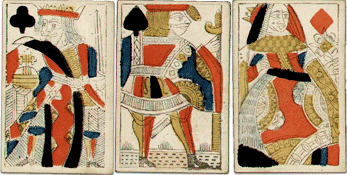
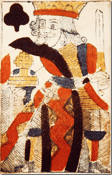
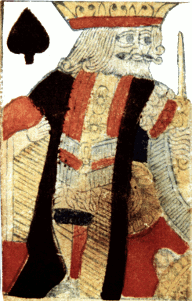
English Playing Cards printed from wood blocks and coloured using stencils, (left) by Blanchard c.1769 and (right) by Joseph Hunt c.1805.
During the 18th century the design of standard English playing cards tended to become set and stereotyped, so that these designs differed less noticeably from maker to maker. Wood blocks were supplied to card makers by a different trade and so a block-maker might have supplied various manufacturers with the same style of court designs. The designs tended to become more distorted, sometimes slightly grotesque, as the features and attributes were corrupted.

Between 1820 and 1840 designs began to be revised, and printing methods evolved, so that, once again, designs between manufacturers became more and more distinctive and competition stimulated innovation. However, it needs to be borne in mind that even as late as the 1870s packs of playing cards were assembled by hand, and that left-overs might have been used to complete another pack. Thus it is sometimes difficult to distinguish these mixed packs from more recent mixes of incomplete packs.
Finally, although De La Rue pioneered letterpress for the production of playing cards in the 1830s, a number of other manufacturers, such as Hunt/Bancks and Reynolds, continued wood-block and stencil use right up until the 1870s. The cutting work and the application of wood blocks had by this time become more refined.


Leave a Reply
Your Name
Just nowRelated Articles

Leadmill playing cards
Promotional pack for an arts centre in Sheffield with designs by Martin F. Bedford.

Agatha Christie and card games
Agatha Christie uses card-play as a primary focus of a story, and as a way of creating plots and mot...

English Heritage
52 different colour photos of historic sites managed by English Heritage.

The Malt Whiskies of Scotland
Three packs featuring photographs by Duncan McEwan of malt whisky distilleries in Scotland.

Typographic Playing Cards
Typographic Playing Cards designed by Jim Sutherland, c.2010.

76: Transitions: Hunt & Sons
Styles change and technology develops. This means that it's possible to see transition periods in th...

Gibson’s History of England
History without tears for young and old, 1920s.

Simpson (Piccadilly) playing cards
Innovative advertising pack for Simpsons of Piccadilly designed by André François.

Scruffy Mutts
‘Scruffy Mutts’ dog-themed playing cards, United Kingdom, c.1998.

Rouen Pattern - Portrait Rouennais
An attractive XV century French-suited design from Rouen became the standard English & Anglo-America...

Hamlet Cigars
Advertising deck for “Hamlet mild cigars”, a Benson & Hedges product.

Heathen Divinities
Handmade playing cards from the British Museum depicting classical Greek and Roman gods and goddesse...

1968 Worshipful Company Pack
Commemorating the Games of the XIX Olympiad, Mexico, 1968 (Master: Michael J. Amberg).

Royal Britain
Pack devised by Pietro Alligo depicting English monarchs from Alfred the Great to Elizabeth II.

Hand-drawn set of 52 playing cards
An imaginatively hand-drawn set of 52 playing cards by an amateur artist, 18th century.

Famous Faces playing cards
Images of the great and the good to be found in the National Portrait Gallery, London.
Trending Articles
Popular articles from the past 28 days



 Your comment here. Your comment here. Your comment here. Your comment here. Your comment here. Your comment here. Your comment here. Your comment here. Your comment here. Your comment here. Your comment here. Your comment here. Your comment here. Your comment here. Your comment here. Your comment here. Your comment here. Your comment here. Your comment here. Your comment here. Your comment here. Your comment here. Your comment here. Your comment here. Your comment here. Your comment here. Your comment here. Your comment here. Your comment here. Your comment here. Your comment here. Your comment here.
Your comment here. Your comment here. Your comment here. Your comment here. Your comment here. Your comment here. Your comment here. Your comment here. Your comment here. Your comment here. Your comment here. Your comment here. Your comment here. Your comment here. Your comment here. Your comment here. Your comment here. Your comment here. Your comment here. Your comment here. Your comment here. Your comment here. Your comment here. Your comment here. Your comment here. Your comment here. Your comment here. Your comment here. Your comment here. Your comment here. Your comment here. Your comment here.